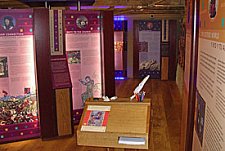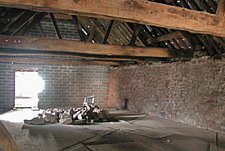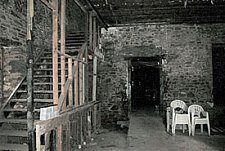TALES OF ABERGAVENNY from the Tithe Barn, St Mary's Priory, Abergavenny
Discover stories from Abergavenny’s colourful past using the interactive multimedia computer touchscreens housed within the exhibition.
 |
The Young Monk
Find out about the life of our young monk and the scandalous goings on at St Mary’s…
As a priory full of monks, you would think St Mary’s was a model of good behaviour, wouldn’t you? Well actually, that wasn’t always the case. In the early 1300s, the monks’ behaviour was so bad that the Bishop of Hereford had to visit and sort things out. He appointed a strict new Prior to run St Mary’s, and as one young monk found out, he wasn’t putting up with any nonsense from his monks
William De Braose
Find out about the infamous ogre, William de Braose, and his dastardly deeds...
After William the Conqueror took the throne in 1066, Norman lords began to seize land in Wales. As you can imagine, the native Welsh people weren’t too happy about that. They particularly hated the 7th Baron of Abergavenny, a chap called William de Braose. De Braose was so ruthless he was nicknamed the ‘Ogre of Abergavenny’, and he certainly lived up to the name, murdering several Welsh chieftains at Abergavenny Castle in 1175 - on Christmas Day no less!
Thomas Gunter
Find out about Thomas Gunter, his secret masses and some of his friends who were unlucky enough to be discovered...
To you and I, the thought of dying for one’s religion might seem a little extreme. But for many people living here in the 17th century, it was a risk worth taking. Not for them the new Protestant faith - no, Abergavenny was a Catholic town through and through. Hundreds risked a martyr’s death to attend Catholic masses in the house of one of Abergavenny’s leading citizens, Thomas Gunter. Most got away with it, but others weren’t so lucky.
The Laywoman
Find out about Mary, the medieval laywoman, and what she got up to during her favourite festivals and feast days...
Have you ever wondered how ordinary men and women lived back in medieval times? The inhabitants of Abergavenny in the 15th century, for example. How did they spend their time? It wasn’t all hard work and dull church services you know. There were plenty of feast days, festivals and celebrations throughout the year that everyone, even the wife of a tenant farmer like our laywoman, could enjoy.
Richard Symonds
Find out about Richard Symonds and his fascinating Civil War diary...
It’s strange to think that a little Welsh town like Abergavenny might have a role to play in national affairs, but during the Civil War of 1642-45, it did. King Charles I himself stayed here, planning his next move against the armies of Parliament. St Mary’s was even immortalised in the diary of one of his troopers, Richard Symonds. Symonds was a great fan of beautiful old buildings, and very taken with St Mary’s he was too.
1000 Years of Abergavenny
 |
 |
c. 75 AD: The Romans maintain a small fort at Abergavenny. They call it Gobannium, which means ‘Place of the Smith'
1087: Norman overlord Hamelin de Ballon builds Abergavenny Castle to hold his new estates in Wales, and founds St Mary’s Priory as a community of 12 Benedictine monks.
1147: Philip de Braose, uncle of the famous Ogre of Abergavenny, William de Braose, sails for Jerusalem with the Second Crusade.
1175: Conflict between Anglo-Norman nobility and the native Welsh is rife. The then Lord of Abergavenny, William de Braose, massacres several Welsh princes at Abergavenny Castle.
1210: William de Braose argues with King John about money and land. He flees to France, and his wife and son starve to death in Windsor Castle.
1310-25: Sir John de Hastings, Lord of Abergavenny, extends St Mary’s Priory to its present dimensions and builds the Tithe Barn.
1404: Owain Glyndwr’s Welsh nationalist army attacks Abergavenny and attempts to burn the Priory.
1541-2: St Mary’s Priory closes as a result of Henry VIII’s Dissolution of the Monasteries. The site is sold and St Mary’s becomes Abergavenny’s parish church.
1590: The Tithe Barn is partially rebuilt, with the height raised to make it a two storey building.
1645: Abergavenny supports Charles I against the forces of Parliament in the Civil War, and the king stays briefly in the town. Royalist trooper Richard Symonds visits St Mary’s Priory.
1660-1820: The Tithe Barn becomes a successful theatre, visited by many illustrious actors and actresses.
1679: The Catholic priest David Lewis of Abergavenny is martyred by the Protestant authorities.
1700s: The roundels, stone shelving and pigeon holes are added to the Tithe Barn.
1800s: The Industrial Revolution brings new industries and prosperity. Abergavenny becomes a centre for Welsh culture.
c.1950: Ye Olde Tythe Barn Discotheque is set up in the Tithe Barn and runs successfully for a number of years.
2002: Restoration work to turn the Tithe Barn into a heritage centre begins.
